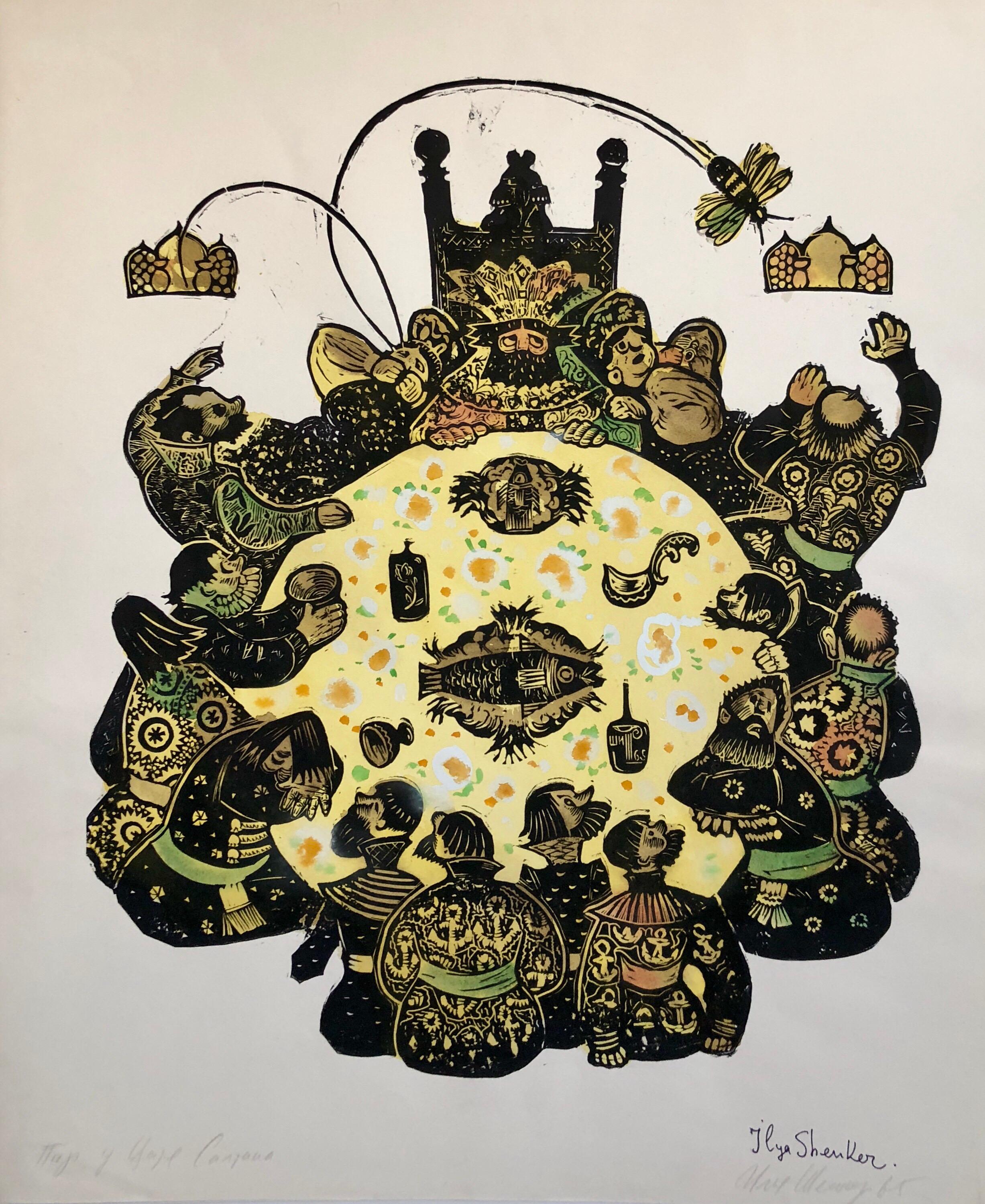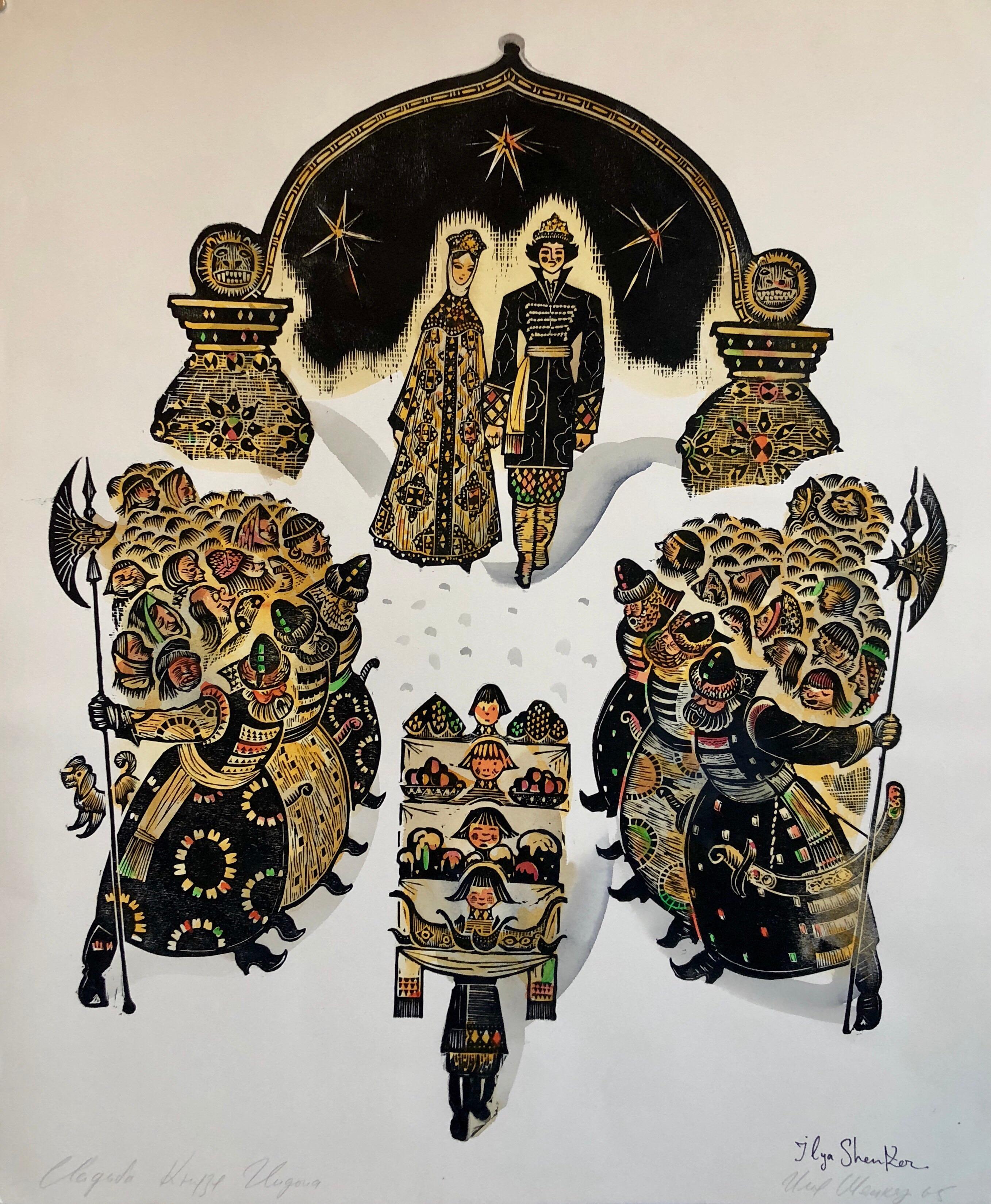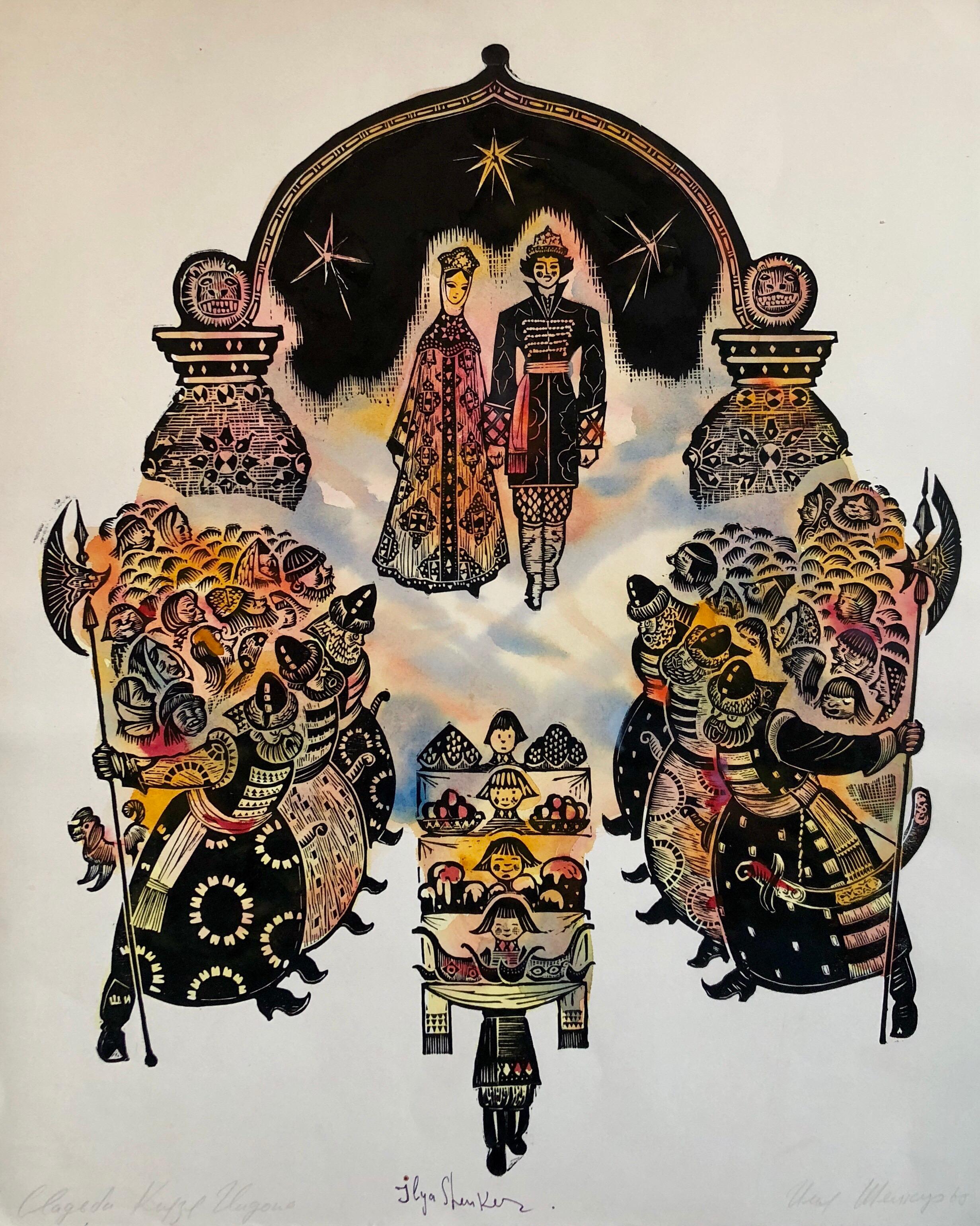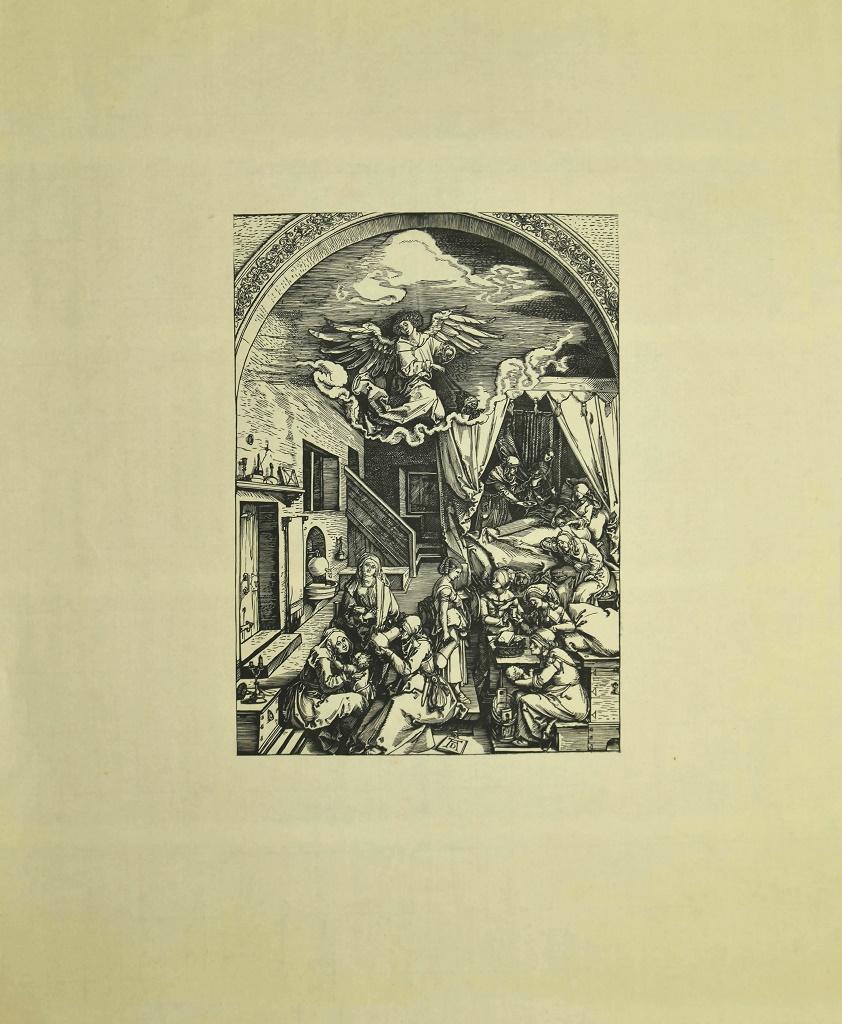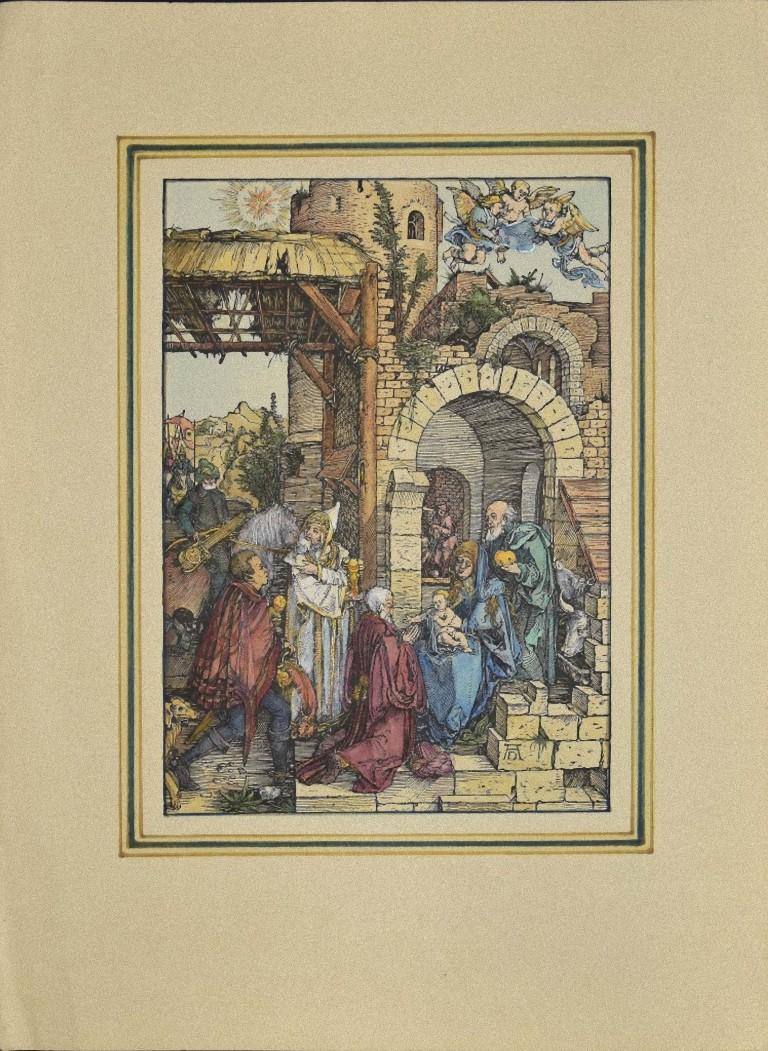Items Similar to Post Soviet Avant Garde Russian Woodcut Print With Hand Watercolor Painting
Want more images or videos?
Request additional images or videos from the seller
1 of 9
Ilya ShenkerPost Soviet Avant Garde Russian Woodcut Print With Hand Watercolor Paintingc.1960s
c.1960s
About the Item
This depicts a wedding scene in a style of German Expressionism. hand signed and hand painted in watercolor.
Ilya Shenker, Russian/American (1922 - )
As a soldier in World War II, he survived where millions perished. Upon returning to his home town of Odessa, felt abandoned and alone. He studied Art and Architecture in Odessa, but, one of a number of Russian Jewish artists allowed to emigrate, he left for America when the opportunity arose. He settled in New York City, a choice that has forever impacted his oeuvre. Many of his pictures depict New York cityscapes and lifestyle; however, they remain typically Russian. His subject matter often comes from memory and includes the life that he left behind, family, and friends. Drawing upon his Jewish heritage for inspiration, Shenker also paints historical events, such as "On the Eve of the Assault" in which he portrayed the last night before the destruction of Jerusalem. He has also illustrated a number of classics of Russian literature including Alexander Pushkin. His use of imagination also applies to the figures in his expressionist paintings—fictional characters such as the Spanish literary character Don Quixote make appearances in his work. He has also placed figures such as Rembrandt and Picasso in modern settings: in "Rembrandt Visiting our Family," Shenker sits his most favored artist at his family table, in a tribute to someone he describes as a "peoples artist." He is one in a long line of great Soviet Russian Judaica Jewish artists beginning with Yehuda Pen, who founded Russia's first art school for Jews in Vitebsk in 1897 continuing with his students, including Marc Chagall and El Lissitzky, Natan Altman, Leon Bakst and Robert Falk, Issachar Ber Ryback and in Abraham Manievich and later to Isaak Brodsky and Grigory Shegal Ilya Kabakov, Komar and Melamid, Erik Bulatov and Leonid Lamm. Ilya Shenker has exhibited works all over the World, and held numerous shows here in the United States. He also has permanent works in several Russian museums.
Selected Exhibitions:
2004- Grant Gallery, SOHO, NY
2000 Fondo del Sol Visual Arts Center and Museum, Washington, D.C.
INTART Museum of Upstate New York at Oneonta, NY
Pace University Gallery at Schimmel Center for the Arts, New York, NY
1986. B.H. Corner Gallery, London, England
1985 Musee de l’Athenee, Geneva, Switzerland
1983 Eduard Nakhamkin Fine Arts, New York
Hamilton Gallery, London, England
1982 - Musee de l'Athenee Geneva, Switzerland
1981 Eduard Nakhamkin Fine Arts, New York
Gallery Graziussi, Venice, Italy
1980 Monaco Fine Art Gallery, Monte Carlo, France
1978 45th Salon des Surindépendants, Musée de Luxembourg, Paris, France
Galeries Raymond Duncan, Paris, France
1977 Nakhamkin Gallery, New York, NY
Art Gallery, New York University, New York, NY
The Rowe House Gallery, Washington, D.C.
1976 Banakh Gallery, New York, NY
Ligoa Duncan Gallery, New York, NY
1971 Alexandria, Egypt
1969 Group Exhibit in Hungary
- Creator:Ilya Shenker (Russian)
- Creation Year:c.1960s
- Dimensions:Height: 24 in (60.96 cm)Width: 19.5 in (49.53 cm)
- Medium:
- Movement & Style:
- Period:
- Condition:minor wear. please see photos.
- Gallery Location:Surfside, FL
- Reference Number:1stDibs: LU38213660562
About the Seller
4.9
Platinum Seller
These expertly vetted sellers are 1stDibs' most experienced sellers and are rated highest by our customers.
Established in 1995
1stDibs seller since 2014
1,549 sales on 1stDibs
Typical response time: 1 hour
- ShippingRetrieving quote...Ships From: Surfside, FL
- Return PolicyA return for this item may be initiated within 3 days of delivery.
More From This SellerView All
- Post Soviet Avant Garde Russian Woodcut Print With Hand Watercolor PaintingBy Ilya ShenkerLocated in Surfside, FLThis depicts a feast style celebration scene in a style of German Expressionism. hand signed and hand painted in watercolor. Ilya Shenker, Russian/American (1922 - ) As a soldier in World War II, he survived where millions perished. Upon returning to his home town of Odessa, felt abandoned and alone. He studied Art and Architecture in Odessa, but, one of a number of Russian Jewish artists allowed to emigrate, he left for America when the opportunity arose. He settled in New York City, a choice that has forever impacted his oeuvre. Many of his pictures depict New York cityscapes and lifestyle; however, they remain typically Russian. His subject matter often comes from memory and includes the life that he left behind, family, and friends. Drawing upon his Jewish heritage for inspiration, Shenker also paints historical events, such as "On the Eve of the Assault" in which he portrayed the last night before the destruction of Jerusalem. He has also illustrated a number of classics of Russian literature including Alexander Pushkin. His use of imagination also applies to the figures in his expressionist paintings—fictional characters such as the Spanish literary character Don Quixote make appearances in his work. He has also placed figures such as Rembrandt and Picasso in modern settings: in "Rembrandt Visiting our Family," Shenker sits his most favored artist at his family table, in a tribute to someone he describes as a "peoples artist." He is one in a long line of great Soviet Russian Judaica Jewish artists beginning with Yehuda Pen, who founded Russia's first art school for Jews in Vitebsk in 1897 continuing with his students, including Marc Chagall and El Lissitzky, Natan Altman, Leon Bakst and Robert Falk...Category
1960s Expressionist Figurative Prints
MaterialsWatercolor, Woodcut
- Post Soviet Avant Garde Russian Woodcut Print With Hand Watercolor PaintingBy Ilya ShenkerLocated in Surfside, FLThis depicts a wedding scene in a style of German Expressionism. hand signed and hand painted in watercolor. Ilya Shenker, Russian/American (1922 - ) As a soldier in World War II, he survived where millions perished. Upon returning to his home town of Odessa, felt abandoned and alone. He studied Art and Architecture in Odessa, but, one of a number of Russian Jewish artists allowed to emigrate, he left for America when the opportunity arose. He settled in New York City, a choice that has forever impacted his oeuvre. Many of his pictures depict New York cityscapes and lifestyle; however, they remain typically Russian. His subject matter often comes from memory and includes the life that he left behind, family, and friends. Drawing upon his Jewish heritage for inspiration, Shenker also paints historical events, such as "On the Eve of the Assault" in which he portrayed the last night before the destruction of Jerusalem. He has also illustrated a number of classics of Russian literature including Alexander Pushkin. His use of imagination also applies to the figures in his expressionist paintings—fictional characters such as the Spanish literary character Don Quixote make appearances in his work. He has also placed figures such as Rembrandt and Picasso in modern settings: in "Rembrandt Visiting our Family," Shenker sits his most favored artist at his family table, in a tribute to someone he describes as a "peoples artist." He is one in a long line of great Soviet Russian Judaica Jewish artists beginning with Yehuda Pen, who founded Russia's first art school for Jews in Vitebsk in 1897 continuing with his students, including Marc Chagall and El Lissitzky, Natan Altman, Leon Bakst and Robert Falk...Category
1960s Expressionist Figurative Prints
MaterialsWatercolor, Woodcut
- Post Soviet Avant Garde Russian Woodcut Print With Hand Watercolor PaintingBy Ilya ShenkerLocated in Surfside, FLThis depicts a wedding scene in a style of German Expressionism. hand signed and hand painted in watercolor. Ilya Shenker, Russian/American (1922 - ) As a soldier in World War II, he survived where millions perished. Upon returning to his home town of Odessa, felt abandoned and alone. He studied Art and Architecture in Odessa, but, one of a number of Russian Jewish artists allowed to emigrate, he left for America when the opportunity arose. He settled in New York City, a choice that has forever impacted his oeuvre. Many of his pictures depict New York cityscapes and lifestyle; however, they remain typically Russian. His subject matter often comes from memory and includes the life that he left behind, family, and friends. Drawing upon his Jewish heritage for inspiration, Shenker also paints historical events, such as "On the Eve of the Assault" in which he portrayed the last night before the destruction of Jerusalem. He has also illustrated a number of classics of Russian literature including Alexander Pushkin. His use of imagination also applies to the figures in his expressionist paintings—fictional characters such as the Spanish literary character Don Quixote make appearances in his work. He has also placed figures such as Rembrandt and Picasso in modern settings: in "Rembrandt Visiting our Family," Shenker sits his most favored artist at his family table, in a tribute to someone he describes as a "peoples artist." He is one in a long line of great Soviet Russian Judaica Jewish artists beginning with Yehuda Pen, who founded Russia's first art school for Jews in Vitebsk in 1897 continuing with his students, including Marc Chagall and El Lissitzky, Natan Altman, Leon Bakst and Robert Falk...Category
1960s Expressionist Figurative Prints
MaterialsWatercolor, Woodcut
- Shtetl Village Doodka Player Judaica Jewish California Modernist Artist EtchingBy Boris DeutschLocated in Surfside, FLBoris deutsch was born in krasnagorka lithuania june 4 1892 died in los angeles 1978.Entered the polytechnic school in riga 1905.School of applied arts berlin 1912. Settled in l.A. 1...Category
20th Century Modern Figurative Prints
MaterialsMixed Media, Watercolor
- Large Watercolor Painting Israeli Modernist Judaica Rabbi with Children, BezalelBy Moshe GatLocated in Surfside, FLA large watercolor painting. Moshe Gat was born in Haifa in 1935. in 1952 he began his studies at the Bezalel School, in Jerusalem. In 1955 he returned to Haifa, where he taught dra...Category
Mid-20th Century Expressionist Figurative Drawings and Watercolors
MaterialsPaper, Watercolor
- Aquatint Etching with Hand Watercolor Painting Jules Pascin SignedBy Jules PascinLocated in Surfside, FLGenre: German Expressionist Subject: Three Noble figures, Noblesse Medium: etching, watercolor paint (I have seen this described as an aquatint and have seen this without color, so i am assuming it is watercolor paint applied to it) Surface: Paper Circa 1920's This is hand signed lower right. the edition is 7/100 Mat measures 15 X 11. window opening about 7 x 7 Julius Mordecai Pincas (March 31, 1885 – June 5, 1930), known as Pascin Jules Pascin, or the "Prince of Montparnasse", was a Bulgarian artist known for his paintings and drawings. He later became an American citizen. His most frequent subject was women, depicted in casual poses, usually nude or partly dressed. Pascin was educated in Vienna and Munich. He traveled for a time in the United States, spending most of his time in the South. He is best known as a Parisian painter, who associated with the artistic circles of Montparnasse, and was one of the emigres of the School of Paris. Having struggled with depression and alcoholism, he committed suicide at the age of 45. Julius Mordecai Pincas was born in Vidin, Bulgaria, the eighth of eleven children, to the Sephardic Jewish family of a grain merchant named Marcus Pincas. Originally from Ruse, the Pincas family was one of the wealthiest in Vidin; they bought and exported corn, rice, maize and sunflower. His mother, Sofie (Sophie) Pincas, belonged to a Sephardic family, Russo, which had moved from Trieste to Zemun, where she and her husband lived before moving to Vidin and where their older children were born. The family spoke Ladino Judaeo-Spanish at home. In 1892, he moved with his parents to Bucharest, where his father opened a grain company, "Marcus Pincas & Co". Pascin worked briefly for his father’s firm at the age of fifteen, but also frequented a local brothel where he made his earliest drawings. His first artistic training was in Vienna in 1902 at age seventeen. In 1903 he relocated to Munich, where he studied at Moritz Heymann's academy. He studied briefly in Berlin where he befriended the Dada artist George Grosz. In 1905 he began contributing drawings to Simplicissimus, a satirical magazine published in Munich. Some portraits recall Otto Dix and Balthus. Because his father objected to the family name being associated with these drawings, the 20-year-old artist adopted the pseudonym Pascin (an anagram of Pincas). He continued to contribute drawings to a Munich daily until 1929. In December 1905, Pascin moved to Paris becoming part of the great migration of Jewish and Eastern European artists to that city (Marc Chagall. Chaim Soutine and Modigliani amongst others) at the start of the 20th century. In 1907 he met Hermine Lionette Cartan David, also a painter, and they became lovers. In that same year he had his first solo exhibition at Paul Cassirer Gallery in Berlin. Despite his social life, Pascin created thousands of watercolors and sketches, plus drawings and caricatures that he sold to various newspapers and magazines. He exhibited his works in commercial galleries and in the Salon d’Automne, the Salon des Indépendants, and the exhibitions of the Berlin Secession and at the Sonderbund-Aussstellung in Cologne. Between 1905 and 1914 he exhibited drawings, watercolors, and prints, but rarely paintings. It was not until about 1907–1909 that he produced his first paintings, which were portraits and nudes in a style influenced by Fauvism and Cézanne. He wanted to become a serious painter, but in time he became deeply depressed over his inability to achieve critical success with his efforts. Dissatisfied with his slow progress in the new medium, he studied the art of drawing at the Académie Colarossi, and painted copies after the masters in the Louvre. He exhibited in the United States for the first time in 1913, when twelve of his works were shown at the Armory Show in New York. Pascin relocated to London at the outbreak of World War I to avoid service in the Bulgarian army and left for the United States on October 3, 1914. A few weeks later on October 31, Hermine David sailed for the United States to join him. Pascin and David lived in the United States from 1914 to 1920, sitting out World War I. They visited New York City, where David had an exhibit. Pascin frequented nightclubs, and met artists such as Yasuo Kuniyoshi and Guy Pene du Bois, but most of his time in America was spent traveling throughout the South. He also visited Cuba. He made many drawings of street life in Charleston, New Orleans, and other places he visited. Some of his works of 1915 and 1916 are in a Cubist style, which he soon abandoned. In 1918 Pascin married Hermine David at City Hall in New York City. Their witnesses were Max Weber and Maurice Sterne, friends and painters who both lived in New York. In September 1920, Pascin became a naturalized United States citizen, with support from Alfred Stieglitz and Maurice Sterne, but returned to Paris soon afterward. There he began a relationship with Lucy Vidil Krohg, who had been his lover ten years earlier but had married the Norwegian painter Per Krohg...Category
Early 20th Century Expressionist Figurative Drawings and Watercolors
MaterialsPaper, Watercolor, Etching
You May Also Like
- Birth of Mary - Woodcut After Albrecht Dürer - Early 20th CenturyBy Albrecht DürerLocated in Roma, ITBirth of Mary is a vintage woodcut print realized after Albrecht Durer in the early 20th Century. The artwork is in good conditions on a cream colored p...Category
Early 20th Century Figurative Prints
MaterialsWoodcut, Watercolor
- Life of the Virgin - Woodcut Reproduction After Albrecht Dürer - 20th CenturyBy Albrecht DürerLocated in Roma, ITLife of the Virgin is an original reproduction water-colored of an original woodcut print realized by Albrecht Dürer (Nuremberg, May 21, 1471 - Nuremberg, April 6, 1528) Berlin Muse...Category
20th Century Figurative Prints
MaterialsWoodcut, Watercolor
- Audrey Hepburn Watercolor Fashion Painting Illustration Drawing on PaperBy Oksana TanasivLocated in Norwalk, CTLimited Edition Geclee Print of 50 Edition, on Watercolor Paper , hand-embellished by watercolor. The size of geclee print is 11"X14" . Size with the white matt is 20″X16″. Frame i...Category
2010s Realist Figurative Prints
MaterialsWatercolor
- Wreath Ukrainian Watercolor Fashion Painting Illustration Drawing on Paper RedBy Oksana TanasivLocated in Norwalk, CTLimited Edition Geclee Print of 50 Edition, on Watercolor Paper , hand-embellished by watercolor. The size of geclee print is 11"X14" . Size with the white matt is 20″X16″. Frame i...Category
2010s Realist Figurative Prints
MaterialsWatercolor
- Mode Vie. Fashion Watercolor Painting Illustration Drawing on PaperBy Oksana TanasivLocated in Norwalk, CTLimited Edition Geclee Print of 50 Edition, on Watercolor Paper , hand-embellished by watercolor. The size of geclee print is 11"X14" . Size with the white matt is 20″X16″. Frame i...Category
2010s Realist Figurative Prints
MaterialsWatercolor
- Ralph Lauren Illustration Watercolor Fashion Painting Illustration Drawing onBy Oksana TanasivLocated in Norwalk, CTLimited Edition Geclee Print of 50 Edition, on Watercolor Paper , hand-embellished by watercolor. The size of geclee print is 11"X14" . Size with the white matt is 20″X16″. Frame i...Category
2010s Realist Figurative Prints
MaterialsWatercolor
Recently Viewed
View AllMore Ways To Browse
Jewish Soldier
Premiere Edition Originale
European Travel Shield
Large Dinner Bell
American Brilliant Water Glasses Flower
Angel Pascual
Mens Gaudy
Scenic Spots Kyoto
Ferdinand Bols Etchings
Matthew Darly
German Erotic Art
Independent Bottle
Gropper War
Andy Warhol Art Signed 2000
Salvador Dali Signed Prints Horse
Munch Sign
Record Organizer
19th C Japanese Prints
